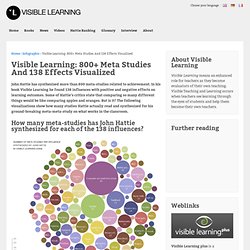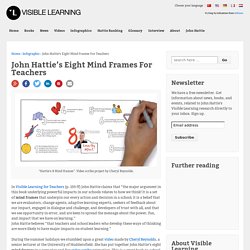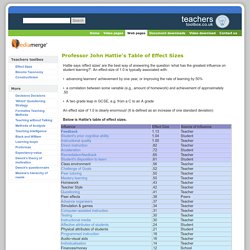

Motivating Students With Effective Feedback and Clarity. Ai-Live sur Twitter : "MT @visiblelearning: RT @ChrisSullivanNZ: What's not working in classrooms by @iPadWells - worth thinking about! Printer-Infographic-A3.pdf. What works in education – Hattie’s list of the greatest effects and why it matters. I have been a fan of John Hattie’s work ever since I encountered Visible Learning.

Hattie has done the most exhaustive meta-analysis in education. Thanks to him, we can gauge not only the relative effectiveness of almost every educational intervention under the sun but we can compare these interventions on an absolute scale of effect size. Perhaps most importantly, Hattie was able to identify a ‘hinge point’ (as he calls it) from exhaustively comparing everything: the effect size of .40. Anything above such an effect size has more of an impact than just a typical year of academic experience and student growth. And an effect size of 1.0 or better is equivalent to advancing the student’s achievement level by approximately a full grade.
The caveat in any meta-anlysis, of course, is that we have little idea as to the validity of the underlying research. Can you guess the next two items on the rank order list? “Home environment” and “socio-economic status.” Like this: Like Loading... Education Week. Hattie's 8 Mindframes. Visible Learning: 800+ Meta Studies And 138 Effects Visualized. John Hattie has synthesized more than 800 meta-studies related to achievement.

In his book Visible Learning he found 138 influences with positive and negative effects on learning outcomes. Some of Hattie’s critics state that comparing so many different things would be like comparing apples and oranges. But is it? The following visualizations show how many studies Hattie actually read and synthesized for his ground-breaking meta-meta-study on what works in the classroom. How many meta-studies has John Hattie synthesized for each of the 138 influences?
The picture shows a relatively balanced distribution of the 800+ meta-studies with an emphasis on “Computer assisted instruction”, “Gender” and “Feedback”. How many underlying studies has John Hattie synthesized for each of the 138 influences? The distribution of the studies underlying the 138 influences is a bit less balanced.
John Hattie's Eight Mind Frames For Teachers. “Hattie’s 8 Mind frames”.

Video scribe project by Cheryl Reynolds. In Visible Learning for Teachers (p. 159 ff) John Hattie claims that “the major argument in this book underlying powerful impacts in our schools relates to how we think! It is a set of mind frames that underpin our every action and decision in a school; it is a belief that we are evaluators, change agents, adaptive learning experts, seekers of feedback about our impact, engaged in dialogue and challenge, and developers of trust with all, and that we see opportunity in error, and are keen to spread the message about the power, fun, and impact that we have on learning.” John Hattie believes “that teachers and school leaders who develop these ways of thinking are more likely to have major impacts on student learning.”
During the summer holidays we stumbled upon a great video made by Cheryl Reynolds, a senior lecturer at the University of Huddersfield. John Hattie. Welcome to Visible Learning. Teachers toolbox - Professor John Hattie's Table of Effect Sizes. Hattie says ‘effect sizes' are the best way of answering the question ‘what has the greatest influence on student learning?

'. An effect-size of 1.0 is typically associated with: • advancing learners' achievement by one year, or improving the rate of learning by 50% • a correlation between some variable (e.g., amount of homework) and achievement of approximately .50 • A two grade leap in GCSE, e.g. from a C to an A grade An effect size of 1.0 is clearly enormous! Below is Hattie's table of effect sizes. Terms used in the table (Interpreted by Geoff Petty) • An effect size of 0.5 is equivalent to a one grade leap at GCSE • An effect size of 1.0 is equivalent to a two grade leap at GCSE • ‘Number of effects is the number of effect sizes from well designed studies that have been averaged to produce the average effect size. • An effect size above 0.4 is above average for educational research Some effect sizes are ‘Russian Dolls' containing more than one strategy e.g.
Beware Over-interpretation! Glossary of Hattie's influences on student achievement. This Glossary explains influences related to student achievement published in John Hattie’s Visible Learning for teachers (Hattie 2012; 251ff).

You can find an older list of influences related to student achievement in Hattie (2009) Visible Learning. 1. Student Self-Reported Grades Self reported grades comes out at the top of all influences. Children are the most accurate when predicting how they will perform. Example for Self-reported grades: Before an exam, ask your class to write down what mark the student expects to achieve. Hattie cites five meta-studies: Mabe/West (1982): Validity of self-evaluation of ability (Abstract)Fachikov/Boud (1989): Student Self-Assessment in Higher Education (Abstract)Ross (1998): Self-assessment in second language testing (Abstract)Falchikov/Goldfinch (2000): Student Peer Assessment in Higher Education (Abstract)Kuncel/Crede/Thomas (2005); The Validity of Self-Reported Grade Point Averages, Class Ranks, and Test Scores (Abstract) 2. 3. 4. 5. 6.